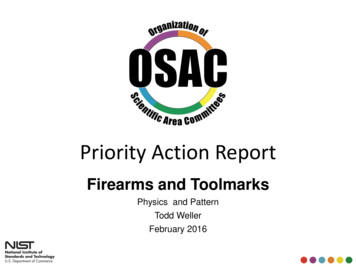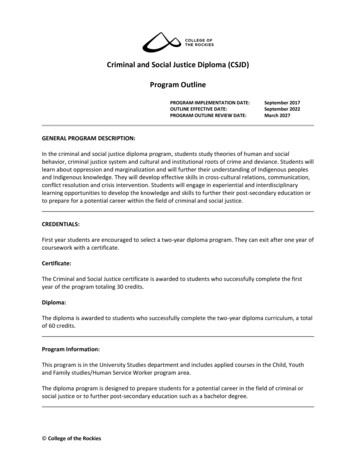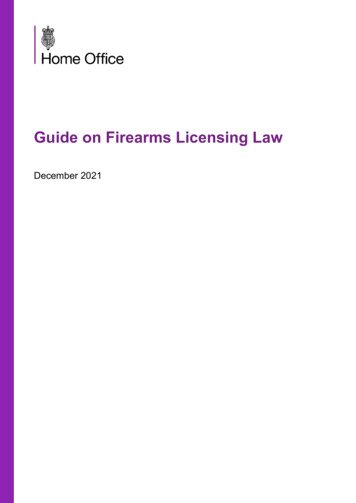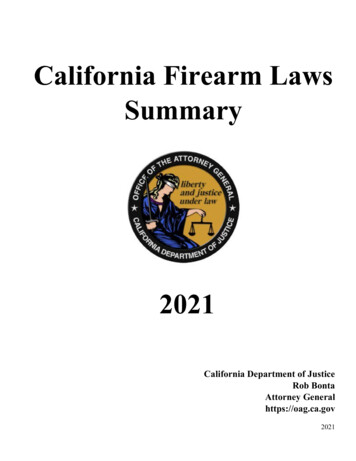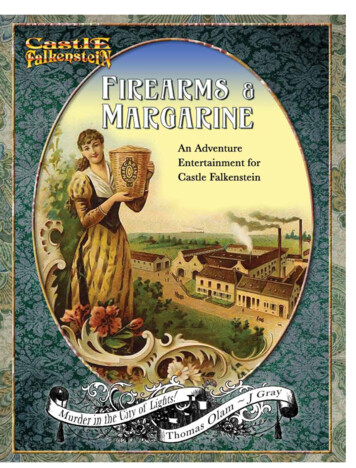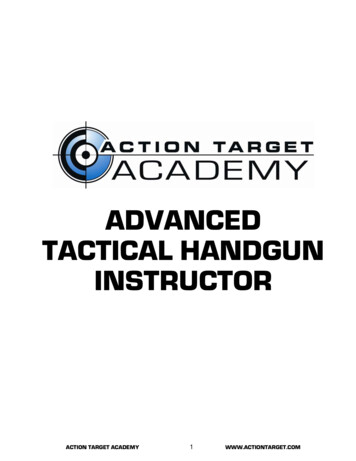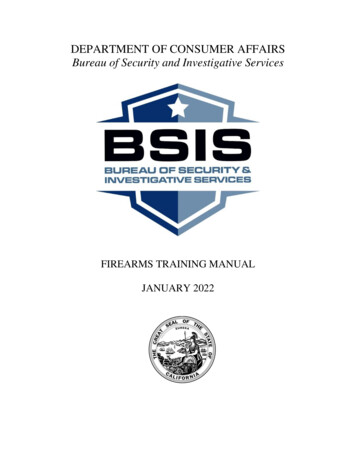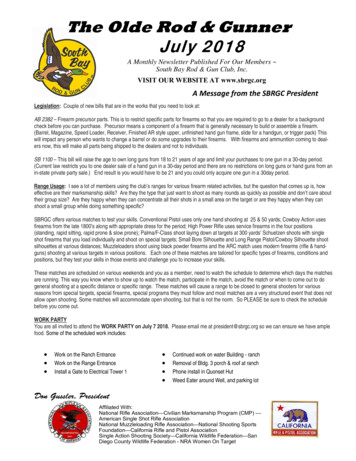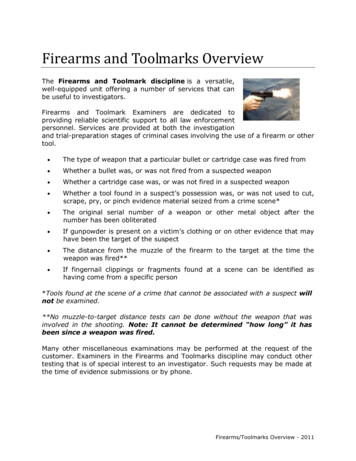
Transcription
Firearms and Toolmarks OverviewThe Firearms and Toolmark discipline is a versatile,well-equipped unit offering a number of services that canbe useful to investigators.Firearms and Toolmark Examiners are dedicated toproviding reliable scientific support to all law enforcementpersonnel. Services are provided at both the investigationand trial-preparation stages of criminal cases involving the use of a firearm or othertool.The type of weapon that a particular bullet or cartridge case was fired fromWhether a bullet was, or was not fired from a suspected weaponWhether a cartridge case was, or was not fired in a suspected weaponWhether a tool found in a suspect’s possession was, or was not used to cut,scrape, pry, or pinch evidence material seized from a crime scene*The original serial number of a weapon or other metal object after thenumber has been obliteratedIf gunpowder is present on a victim’s clothing or on other evidence that mayhave been the target of the suspectThe distance from the muzzle of the firearm to the target at the time theweapon was fired**If fingernail clippings or fragments found at a scene can be identified ashaving come from a specific person*Tools found at the scene of a crime that cannot be associated with a suspect willnot be examined.**No muzzle-to-target distance tests can be done without the weapon that wasinvolved in the shooting. Note: It cannot be determined “how long” it hasbeen since a weapon was fired.Many other miscellaneous examinations may be performed at the request of thecustomer. Examiners in the Firearms and Toolmarks discipline may conduct othertesting that is of special interest to an investigator. Such requests may be made atthe time of evidence submissions or by phone.Firearms/Toolmarks Overview - 2011
Firearms AnalysisBasics of Firearms ComparisonsInside the barrels of handguns and rifles are spiral impressionscalled rifling. The raised portions of the rifling are known aslands and the recessed portions are known as grooves. When aweapon is fired, these lands and grooves cut into the bullet,putting spin on it as it travels through the barrel of a firearm.Because bullets have an oblong shape, spin is necessary foraccurate flight.The impressions oflands and groovesremain on the bulletit has been fired.afterSince rifling characteristics can differ from one firearmmanufacturer to another, forensic firearm examiners candetermine the type of weapon that fired a particularbullet by examining the impressions of the lands andgrooves on the bullet. They examine the width, thenumber, and the direction of the twist of the lands andgrooves. For example, a 9mm pistol made by onecompany might have a barrel with 6 lands and groovesthat twist to the right and another company's 9mm mighthave 6 that twist to the left. In addition, the width of thelands and grooves may differ.Because each barrel will have imperfections left by the manufacturing process thatwill leave unique marks on a bullet, firearm examiners can determine whether abullet recovered from a crime scene or victim was fired from a weapon taken froma suspect.Firearms/Toolmarks Overview - 2011
Comparison ProcessThe first step in the Comparison Process is to test fire thefirearm into a water tank in the lab.BulletsThe second step involves using acomparison microscope to compare thetest bullet to the bullet recovered fromthe victim or crime scene.weapon.The photo on the left shows the splitscreen image the scientist sees using thecomparison microscope. The right side ofthe photo shows the test bullet fired fromthe suspect's gun into the water tank andthe left side, the bullet recovered fromthe crime scene. The marks or striationson each bullet match, indicating that thetwo bullets were fired from the sameCartridge CasingsFirearms/Toolmarks Overview - 2011
Since a gun will also leave unique marks on cartridge cases, cases left at crimescenes can link a suspect's weapon to the crime.The following photographs of split screen images from a comparison microscopeshow three different types of markings left on cases that firearm examiners can usein determining if the cases were fired from the same weapons.Firing pin impressions - When a weapon'strigger is pulled, the firing pin is forced into theprimer cup located at the rear center of thecartridge.Breech face marks- These marks come fromthe area surrounding the firing pin of the gun.After the cartridge powder is ignited by thefiring pin striking the primer cup, tremendouspressure is exerted in the chamber of theweapon, forcing the back of the cartridge caseagainst the breech face of the weapon.Extractor marks - After a semi-automatic pistolhas been fired, an extractor pulls the cartridgefrom the chamber and ejects it from the pistol.Firearms/Toolmarks Overview - 2011
IBISThe Integrated Ballistic Identification System (IBIS) is used to associate evidence inpreviously unsolved crimes. IBIS is a highly technical, computerized image analysissystem that records striated images from bullets and cartridge cases and comparesthem to a national, and growing international, database of images.Cartridge cases recovered from victims and crime scenes are placed into thesystem and comparisons are made when agencies submit confiscated suspectweapons to the laboratory for testing.The images from the test fires are compared against the entire database. Theseimages can be compared in a very few seconds, an impossible task for a firearmsexaminer using conventional procedures. These images are correlated by the IBISsystem and given a score as to a possible match. The results of this correlation arecalled High Confidence Candidates, or HCCs.The firearms examiner makes a final determination to a positive match which thenbecomes a Hit. When a Hit has occurred, the involved law enforcement agenciesare notified and they can then take the appropriate investigative and legal actions.Toolmark ExaminationThe Firearms and Toolmark discipline receives tools suspected of being associatedwith a crime scene. Cutting, pinching, prying,and striking tools are all examined by thisdiscipline. Great care must be taken by theofficer to protect the marking surfaces on thetool. If the entire tool cannot be wrapped,the tool’s marking surface should beprotected using whatever materials areavailable to the officer. It should beunderstood that tools found at the crimescene that cannot link a person to the scenewill not be examined. Materials recoveredfrom the crime scene that are suspected ofbeing marked by the recovered tool should be carefully removed from the scene sothat the marks are not disrupted. Any cuts made by the officer to remove thesuspect areas should be clearly marked so as not to be confused with the suspectareas. Each item should be packaged separately and submitted to the laboratory.Firearms/Toolmarks Overview - 2011
Tools also leave unique marks that can provide important clues in linking a suspectto a crime. The photo on the right is a split screen comparison of copper wires cutby a wire cutter found in the possession of a burglary suspect. The test cut on theright matches the evidence cut from the crime scene.A maul recovered from a burglary suspect iscompared against the indentation left in thevictim's doorjamb.The maul fits the indentation perfectly,providinglocalinvestigatorswithevidence to charge the suspect in theburglary.Firearms/Toolmarks Overview - 2011
Evidence SubmissionsThe following are general requirements for officers and other law enforcementpersonnel in collecting and submitting evidence for Firearms and Toolmarksanalysis. As in all cases, common sense should be used when attempting to protectthe integrity of evidence.FirearmsFirearms should be collected carefully so that no parts of the gun are damaged.Officers should make sure that nothing comes in contact with either the inside ofthe barrel or the breech face, which is where the head of the cartridge rests beforefiring. All weapons must be unloaded prior to submission to the laboratory. If theweapon cannot be unloaded prior to submission, the packaging must be clearlylabeled ‘LOADED WEAPON’.Weapons Recovered From WaterWeapons removed from fresh water must be placed in the same water forsubmission to the laboratory. Small lunch coolers work very well for handguns. Inthe event that a rifle or shotgun is removed from a lake or pond but can’t fit into acontainer, the weapon should be sprayed heavily with WD-40 or other lubricant andtaken to the laboratory as soon as possible. The slightest bit of rust to the inside ofthe barrel will alter the individual characteristics necessary to make identification. Ifthe gun is removed from the water, it must be oiled, making sure that the inside ofthe barrel is sprayed or filled with oil. This will slow the oxidation process. Weaponsremoved from salt water should be rinsed, heavily oiled and brought to the crimelaboratory. Heavily bloodstained weapons should be packaged in boxes with abiohazard label.Protecting the Weapon from DamageDo not insert foreign objects into any part of the gun such as the barrel or ejectionport. In the event the gun will be dusted for fingerprints or super glued, block bothends of the barrel gently with tape. This will prevent residue from building up insideof the barrel. If a loaded gun is submitted to the laboratory, you must notify DOFSpersonnel for instructions prior to submitting the weapon. Insure that the containeris properly marked indicating that the firearm is loaded. Loaded firearms must behand carried to the laboratory – do not leave in the lock box. Do not dry fire orwork the action of any weapon that is to be submitted to the crime lab. Leavingempty cartridge cases in the chamber of a revolver when submitted might assistthe examiner in determining from which chamber the round was fired.Firearms/Toolmarks Overview - 2011
Bullets, Cartridge Cases and CartridgesWhen bullets and cartridge cases are submitted for analysis, they should be individuallypackaged in their own canister, envelope, or other small container. Bullets(especially lead) should be lightly wrapped in tissue or cotton so that the bullet surface willbe protected from possible damage.Do not mark or engrave any surface on a bullet or cartridge case as this maydamage individual characteristics. If evidence must be marked, mark thecontainer itself.Do not let any metal object such as forceps, knives or screwdrivers come intocontact with a bullet. Metal objects will scratch the surface and alter themarkings used for identification.Numerous cartridge cases recovered from the same area may be packagedtogether in one container to save time and supplies.Be sure to collect any wads or pellets in cases involving a shotgun. Undercertain circumstances a wad can be matched to the barrel of a shotgun,especially if it has a sawed-off barrel.Film canisters or pillboxes make excellent containers for packaging bulletsand cartridge cases.ClothingClothing submitted to the laboraotry to be checked for gunpowder should bepackaged in a paper bag or box. Do not package wet or bloody clothes until theyhave air-dried. Wet clothes will mold, making them difficult to examine. Inform thefirearms examiner of how the layers of clothing were worn in order to assist indetermining the path of the bullet. This information should be written on theevidence bag or the submission form. The Firearms discipline also performs muzzleto-target distance determinations. In order to perform this service, the gunidentified as being used in the shooting must also be submitted. If no gun has beenseized, the examination will be limited to a search for gunpowder or a gunpowderpattern.AutomobilesIf it is necessary to have a firearms examiner examine a car or other vehicleassociated with a shooting incident, the vehicle should be photographed andtransported to the crime laboratory as soon as possible. Officers in charge mustensure that glass shattered or cracked by a projectile does not break further duringthe transport. Examining the glass fracture patterns can make valuable conclusions.Firearms/Toolmarks Overview - 2011
Do not mark or engrave any surface on a bullet or cartridge case as this may damage individual characteristics. If evidence must be marked, mark the container itself. Do not let any metal object such as forceps, knives or screwdrivers come into contact with a bullet. Metal objects will scratch the surface and alter the

![firearms qualifications [PFP#730045656]](/img/59/firearms2003.jpg)

